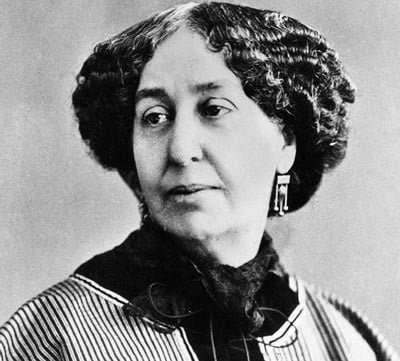Born: July 1, 1804, Paris
Died: June 8, 1876, Nohant, France

George Sand, pseudonym of Amandine Aurore Lucile, Baronne Dudevant, was a French novelist of the romantic movement, whose irregular life and many love-affairs shocked Parisian society.
Sand was born in Paris on July 1, 1804, the daughter of a French army officer named Dupin who was descended from King Augustus II of Poland. Most of her childhood was spent in the country at Nohant, in Berry, except for convent education in Paris. She married Casimir Dudevant, a country squire, in 1822 but soon became bored and left her husband. In 1831, she moved to Paris and joined a group of distinguished artists that included the French novelist Honouré de Balzac and the Hungarian composer Franz Liszt. She became celebrated both for her writings and for her romantic liaisons, particularly those with the French poet Alfred de Musset and the Polish composer Frédéric Chopin.
Sand was a prolific writer, expressing in her works a deep concern for human problems and strong feminist ideals. She wrote her first two novels in collaboration with the French novelist Jules Sandeau. They were published under the name Jules Sand, which suggested the pseudonym she adopted for her next work, Indiana (1832). Her writings generally are divided into four periods. The novels of the first period (1832-1836) were idealistic and romantic, typical examples being Valentine (1832) and Lélia (1833). They, like Indiana, exalted free love unhampered by conventional marriage. The second period (1840-1848) was devoted to such novels as Consuelo (1842), in which she expounded socialistic and humanitarian ideals. After the Revolution of 1848, she retired permanently to her country house at Nohant, where she wrote the novels of her third period (1848-1860), concerned with country life and the peasants, including François le Champi (1848) and La Petite Fadette (1849). Her last novels, which returned to wider social considerations and were judged among her best, include Le Marquis de Villemer (1861) and Mlle. de Quintinie (1863). She also wrote her autobiography, Histoire de ma vie (1854-1855; Story of My Life), and Contes d’une grand’mère (1873; Tales of a Grandmother), a collection of stories she wrote for her grandchildren. She died at Nohant on June 8, 1876.
Although Sand’s novels were widely read in her time and were a strong influence on young writers yet they gradually lost favour. With the recent development of feminist criticism, interest in her life work has significantly revived.

